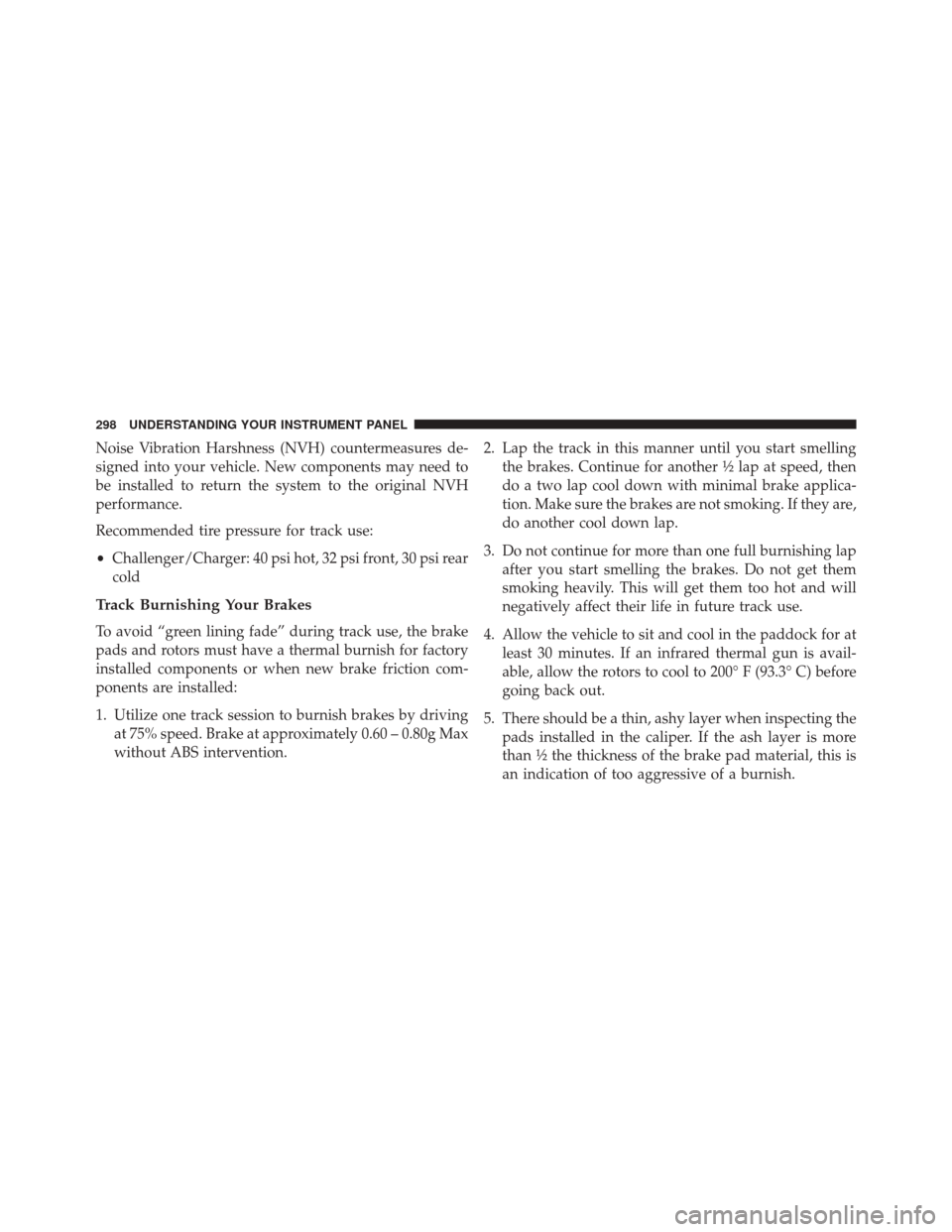Page 300 of 616

Noise Vibration Harshness (NVH) countermeasures de-
signed into your vehicle. New components may need to
be installed to return the system to the original NVH
performance.
Recommended tire pressure for track use:
•Challenger/Charger: 40 psi hot, 32 psi front, 30 psi rear
cold
Track Burnishing Your Brakes
To avoid “green lining fade” during track use, the brake
pads and rotors must have a thermal burnish for factory
installed components or when new brake friction com-
ponents are installed:
1. Utilize one track session to burnish brakes by driving at 75% speed. Brake at approximately 0.60 – 0.80g Max
without ABS intervention. 2. Lap the track in this manner until you start smelling
the brakes. Continue for another ½ lap at speed, then
do a two lap cool down with minimal brake applica-
tion. Make sure the brakes are not smoking. If they are,
do another cool down lap.
3. Do not continue for more than one full burnishing lap after you start smelling the brakes. Do not get them
smoking heavily. This will get them too hot and will
negatively affect their life in future track use.
4. Allow the vehicle to sit and cool in the paddock for at least 30 minutes. If an infrared thermal gun is avail-
able, allow the rotors to cool to 200° F (93.3° C) before
going back out.
5. There should be a thin, ashy layer when inspecting the pads installed in the caliper. If the ash layer is more
than ½ the thickness of the brake pad material, this is
an indication of too aggressive of a burnish.
298 UNDERSTANDING YOUR INSTRUMENT PANEL
Page 301 of 616

6. Sometimes, a second burnish session is required. If thebrake pads start smelling in the next track session,
reduce speed and braking deceleration to burnish
targets and follow steps 2 through 4.
7. New brake pads installed on old rotors still need to be burnished. New rotors installed with old pads should
be burnished at the track, or street driven for 300 city
miles, to develop an adequate lining transfer layer on
the rotor surface prior to track use.
8. Rotors that pulsate during track use should be re- placed. Resurfacing of the rotors is not recommended,
as it removes mass from the rotor, reducing its thermal
capacity. Resurfacing also thins the rotor cheek, mak-
ing it less robust and increasing the likelihood of
pulsation in further track use.SRT PERFORMANCE PAGES
Performance Pages is an application that provides a
display for performance indicators, as received from the
Instrument Cluster, that will help you gain familiarity
with the capabilities of your SRT vehicle in real-time.
To access the SRT Performance Pages, press the “Apps”
button on the touchscreen, then press the “SRT Perfor-
mance” button on the touchscreen, or press “SRT Pages”
in the top left of the touchscreen while in Drive Modes.
Press the desired button on the touchscreen to access that
specific Performance Page.
WARNING!
Measurement of vehicle statistics with the SRT Per-
formance Pages is intended for off-highway or off-
road use only and should not be done on any public
(Continued)
4
UNDERSTANDING YOUR INSTRUMENT PANEL 299
Page 413 of 616

NOTE:It is recommended that you target 40psi (276kpa)
Hot Tire Pressure at the conclusion of each track session.
Starting at 32psi (221kpa) Front & 30psi (207 kpa) Rear
Cold and adjusting based on ambient & track conditions
is recommended. Tire pressure can be monitored via the
Driver Information Display (DID) and can assist with
adjustments.
Track burnishing your brakes:
To avoid “green lining fade” during track use, the brake
pads and rotors must have a thermal burnish for factory
installed components or when new brake friction com-
ponents are installed:
1. Use one track session to burnish brakes by driving at 75% speed. Brake at approximately 0.60-0.80g max
without ABS intervention.
2. Lap the track in this manner until you start smelling the brakes. Continue for another ½ lap at speed, then do a two lap cool down with minimal brake applies.
Make sure the brakes are not smoking. If they are, do
another cool down lap.
3. Do not continue for more than 1 full burnishing lap after you start smelling the brakes. Do not get them
smoking heavily. This will get them too hot and affect
their life negatively in future track use.
4. Allow vehicle to sit and cool in the paddock for at least 30 min. If an infrared thermal gun is available, allow
rotors to cool to 200°F (93.3°C) before going back out.
5. There should be a thin, ash layer when inspecting the pads installed in the caliper. Having the ash layer go
more than half the thickness of the pad material
indicates too aggressive of a burnish.
5
STARTING AND OPERATING 411
Page 437 of 616
Ready Alert Braking (RAB)
Ready Alert Braking may reduce the time required to
reach full braking during emergency braking situations.
It anticipates when an emergency braking situation may
occur by monitoring how fast the throttle is released by
the driver. The EBC will prepare the brake system for a
panic stop.
Rainy Brake Support (RBS)
Rainy Brake Support may improve braking performance
in wet conditions. It will periodically apply a small
amount of brake pressure to remove any water buildup
on the front brake rotors. It functions when the wind-
shield wipers are in LO or HI speed. When Rainy Brake
Support is active, there is no notification to the driver and
no driver interaction is required.
5
STARTING AND OPERATING 435